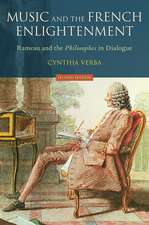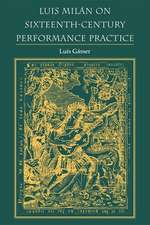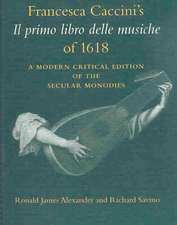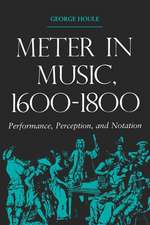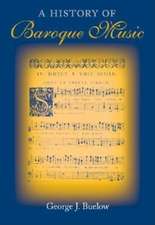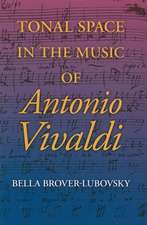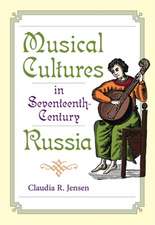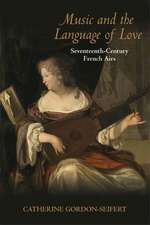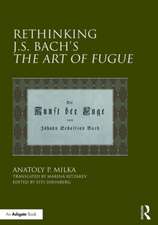The Italian Cantata in Vienna – Entertainment in the Age of Absolutism
Autor Lawrence Bennetten Limba Engleză Hardback – 17 oct 2013
Preț: 383.87 lei
Nou
Puncte Express: 576
Preț estimativ în valută:
73.46€ • 76.41$ • 60.65£
73.46€ • 76.41$ • 60.65£
Carte tipărită la comandă
Livrare economică 15-29 aprilie
Preluare comenzi: 021 569.72.76
Specificații
ISBN-13: 9780253010186
ISBN-10: 0253010187
Pagini: 392
Ilustrații: 119 music exerpts, 5 b&w illustrations
Dimensiuni: 164 x 247 x 28 mm
Greutate: 0.58 kg
Editura: Wiley
ISBN-10: 0253010187
Pagini: 392
Ilustrații: 119 music exerpts, 5 b&w illustrations
Dimensiuni: 164 x 247 x 28 mm
Greutate: 0.58 kg
Editura: Wiley
Cuprins
PrefaceList of Bibliographical AbbreviationsList of RISM Sigla1. IntroductionThe Role of Music in the Daily Lives of the HabsburgsThe Scope of the BookThe Secondary LiteratureThe Cantata TerminologyForerunners of the Cantata in ViennaPart I: The Cantata in Vienna, 1658-17002. The Political and Cultural MilieuHistorical BackgroundLeopold I as Patron and ComposerHabsburg Music Chapels, 1658-1700Occasions, Places of Performance, and PerformersLibrettists3. The ComposersComposers Who May Have Written Cantatas for Vienna During the EarlyReign of Leopold IAntonio and Carlo DraghiFilippo VismarriCarlo CappelliniGiovanni Battista PederzuoliAntonio Maria and Giovanni Buonaventura VivianiGerman-Speaking Composers4. Repertoire and SourcesThe RepertoireThe Sources5. Text and MusicAntonio Maria VivianiAntonio BertaliFilippo VismarriCarlo CappelliniGiovanni Battista PederzuoliAntonio and Carlo DraghiPart II: The Cantata in Vienna, 1700-17116. The Political and Cultural MilieuHistorical BackgroundJoseph I as Patron and ComposerCultural GrowthHabsburg Music Chapels, 1700-1711Genre DesignationsOccasions, Places of Performance, and PerformersLibrettists and Librettos7. The ComposersCarlo Agostino BadiaGiovanni BononciniMarcAntonio ZianiAttilio AriostiAntonio Maria BononciniComposers Who May Have Written Cantatas for Vienna8. Repertoire and SourcesNew Interest in the CantataThe Repertoire of Cantatas by Habsburg ComposersSources9. Style OverviewThe Style TransitionBroad Structural PlansSelection of VoicesInstrumentationDynamicsRecitative and AriosoAria KeysContinuum (Tempo/Meter)The Use of DevisenAria Designs10. Aspects of FormThe Conventional Da Capo DesignVariants from the Conventional DesignArticulation of Form11. Melody, Harmony, and RhythmMelodyHarmonySurface RhythmChanges in Timbre12. The Relationship of Text and MusicThe Text and Its Influence upon the Musical DesignThe Interactions of the Text with Melody and RhythmTone Color and DynamicsDescriptive Treatment of the TextAffective Treatment of the Text13. Conclusion: The Interregnum and Its AftermathThe End of the War of the Spanish SuccessionThe Fate of the Cantata Composers and Librettists Who Served Joseph IThe Cantatas by Composers Residing in Vienna During the InterregumAppendix A: Index of Cantata Text Incipits and SourcesAppendix B: Catalogue Raisonné of Viennese Cantata SourcesAppendix C: Texts of Arias Analyzed in Chapters 10-12NotesBibliography
Recenzii
"This book contains a wealth of new information. It comes from a scholar who writes clearly and perceptively, and who has devoted decades of attention to the material." Steven Saunders, Charles A. Dana Professor of Music, Colby College
"This book contains a wealth of new information. It comes from a scholar who writes clearly and perceptively, and who has devoted decades of attention to the material." - Steven Saunders, Charles A. Dana Professor of Music, Colby College
"This book contains a wealth of new information. It comes from a scholar who writes clearly and perceptively, and who has devoted decades of attention to the material." - Steven Saunders, Charles A. Dana Professor of Music, Colby College





